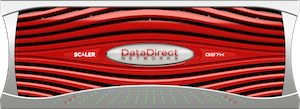 Storage has been a hot topic once again at SC14 with a number of announcements concerning new technology. With ever increasing data volumes HPC users need to be aware of developments in the HPC storage market as new technology can increase productivity of an HPC system.
Storage has been a hot topic once again at SC14 with a number of announcements concerning new technology. With ever increasing data volumes HPC users need to be aware of developments in the HPC storage market as new technology can increase productivity of an HPC system.
DDN has announced the latest generation of EXAScaler, the company’s high performance Lustre appliance, with support from DDN and Intel. This was followed by the news that DDN has revealed preliminary customer adoption and the latest performance testing of its Infinite Memory Engine (IME) burst buffer and application acceleration technology.
Dot Hill, a supplier of enterprise-class storage systems, unveiled a new scale-out high performance Lustre file serving solution in collaboration with Intel for software and management and Mellanox for networking. The company has also announced the Dot Hill Ultra56 AssuredSAN, a new hybrid flash storage array based on an ultra-density chassis.
DDN’s new version of EXAScaler, much like previous versions, is aimed at applications that demand high performance and large IOPS throughput. In a single 45 unit rack, the new EXAScaler delivers over 4.8PB of usable storage using 6TB disk drives, 100MB per second sustained scalable per-drive performance, up to 40GB per second sustained throughput and up to 1.5 million IOPS.
The newest version of the solution is also capable of high sustained Lustre metadata performance, capable of exceeding 100,000 file creates per second, even when creating millions of files under intensive load.
Powered by Intel Enterprise Edition for Lustre software (Intel EE for Lustre software), DDN EXAScaler integrates file system and storage media into one extremely high performance file storage appliance to provide throughput and parallel access that traditional enterprise SAN and NAS storage technologies lack today.
DDN also announced that it is providing 24 hour enterprise grade support for the new EXAScaler appliance.
The Infinite Memory Engine (IME) is designed for a broad range of performance hungry HPC applications such as Big Data across life sciences, oil and gas, research and financial services industries among others, where support for high bandwidth and high IOPS workloads is essential.
In this video, Molly Rector from DDN describes the company’s new IME Infinite Memory Engine. Recorded right after the DDN User Group Meeting at SC14.
DDN is placing previews of IME technology into leading HPC facilities around the world and currently has placed test beds in over a dozen Top100 sites.
DDN’s IME is an application-aware, non-volatile memory enabled acceleration engine and buffer cache. IME resides between the high-performance compute and parallel file system in an HPC environment, and maximises compute utilisation without crippling the storage back-end. By virtualising SSDs across the entire environment into a single fast tier of storage, users now can take advantage of the declining price of commodity hardware and deliver near in-memory performance to accelerate I/O, reduce latency and provide greater operational and economic efficiency.
Dot Hill’s first announcement focused on a new scale-out, Lustre file serving solution for HPC. The Dot Hill parallel distributed file system solution provides a massively scalable and high performance infrastructure for use in a broad range of high performance computing industries.
The Lustre file system is capable of more than a terabyte per second of aggregate I/O throughput. Performance of up to 6GB per second throughput is achieved with each individual storage module, and scaled linearly with added modules. Furthermore, InfiniBand network paths deliver up to 56GB per second throughput to each compute node.
Bill Wuertz, senior vice president of products and solutions, Dot Hill said: “Extreme data analysis and data modelling is being employed by scientists and technologists who are tasked with solving the world’s toughest issues. Dot Hill storage has been engineered to maintain high performance for randomised sequential workloads. Data storage systems must adapt to this dynamic landscape by offering solutions that provide density, scalability and performance, and yet are simple to manage and affordable.”
The other big announcement from Dot Hill was the release of the Dot Hill Ultra56 AssuredSAN, a new hybrid flash storage array based on an ultra-density chassis. The Ultra56 AssuredSAN includes the same dual active, redundant 4004 controllers as other Dot Hill storage arrays, affording up to 6,400 MB per second of sustained read performance and complete meta-data compatibility within the Dot Hill family of storage solutions.
On display at SC14, the Ultra56 is available with Dot Hill’s RealStor version 2.0 application workload-aware intelligence software, which maximises performance and simplifies management of hybrid storage arrays.
Hybrid flash arrays support any combination of SSDs and hard disk drives to best suit application needs. Using 6TB hard drives means that 336TB of raw capacity can be achieved per chassis. Three Ultra56 expansion enclosures can be added for a total of 1.34PB of storage within a single array.
Bill Wuertz, senior vice president of products and solutions, Dot Hill said: “Enhancing our portfolio of Ultra solutions and leveraging our Ultra48 design for small form factor drives, we’ve designed a unique chassis for large form factor devices with the Ultra56. With all the requisite features, as well as outstanding performance and high capacity, the Ultra56 is well-suited for our growing base of vertical market and service provider customers. This solution, which includes RealStor 2.0 application workload-aware intelligence, provides Dot Hill partners with a significantly differentiated offering for high performance computing and ruggedized applications.”
Dot Hill Ultra56 Fibre Channel/iSCSI and SAS arrays will be available in Januray 2015.
This story appears here as part of a cross-publishing agreement with Scientific Computing World.



